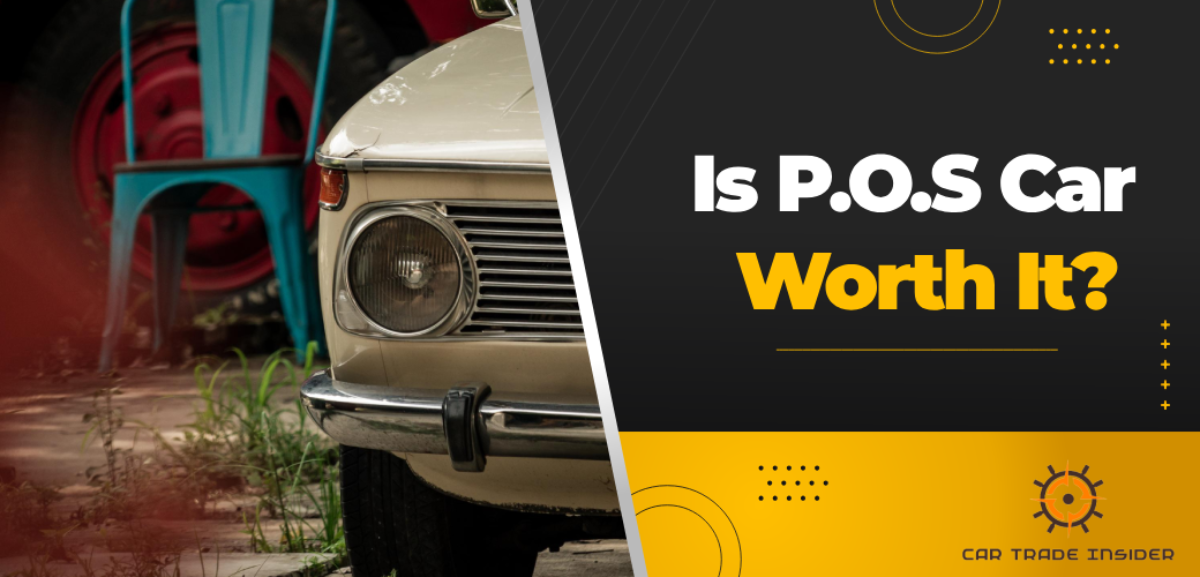In the world of car buying, there’s a unique category known as P.O.S. (Piece of Shit or beaters) cars. These vehicles are usually older, have high mileage, and may not be in the best condition aesthetically or mechanically.
While the term P.O.S. might sound derogatory, some car enthusiasts and budget-conscious individuals consider purchasing these cars for various reasons.
In this article, we will explore the benefits and drawbacks of buying a P.O.S. car to help you make an informed decision if you ever come across one in the used car market.
What is a P.O.S. Car?
A P.O.S. car is typically an older vehicle that has seen better days. It may have significant wear and tear, potential mechanical issues, and a lack of modern features and technology. People often associate these cars with low prices, but they may require more maintenance and repairs than newer models.
The Benefits of Buying a P.O.S. Car
Cost Savings
One of the main reasons people consider buying a P.O.S. car is the cost savings. These vehicles are often significantly cheaper upfront compared to newer models, making them a tempting choice for those on a tight budget.
Lower Insurance Premiums
As P.O.S. cars have lower market values, insurance companies usually offer lower premiums for these vehicles. This can result in substantial savings on insurance costs over time.
Minimal Depreciation
New cars can lose a significant portion of their value through depreciation during the first few years of ownership. P.O.S. cars, being older and already depreciated, don’t experience the same level of value loss.
Easier Maintenance
P.O.S. cars are relatively simple machines, and their parts are usually more affordable compared to high-tech components found in modern vehicles. This can make repairs and maintenance more manageable for car owners.
The Drawbacks of Buying a P.O.S. Car
Reliability Concerns
One of the most significant drawbacks of P.O.S. cars is their reliability. With high mileage and potential mechanical issues, these vehicles may be prone to breakdowns and require frequent repairs.
Safety Issues
Older cars often lack modern safety features, such as advanced airbags, stability control, and collision avoidance systems, making them less safe in certain driving conditions. Older cars may also be more likely to have rust or other structural damage, which could make them less safe in a crash.
Related Article: Can you sell a car with a rusted frame
Limited Features and Technology
P.O.S. cars may not have the latest infotainment systems, navigation, or smartphone connectivity options, which can be inconvenient for tech-savvy drivers.
Lower Resale Value
While the initial cost savings might be attractive, P.O.S. cars also have lower resale values due to their age and condition. This can make it harder to recoup your investment when you decide to sell or trade in the vehicle.
Factors to Consider When Buying a P.O.S. Car
Age and Mileage
The age and mileage of a P.O.S. car are crucial factors to consider. A well-maintained older car with lower mileage might be a better choice than a newer car with high mileage and questionable history.
Maintenance History
It’s essential to obtain a detailed maintenance history of the P.O.S. car you’re considering. Regular maintenance indicates the previous owner’s care for the vehicle.
Inspection and Test Drive
Before purchasing a P.O.S. car, always have it inspected by a qualified mechanic and take it for a test drive. This step will help identify any potential issues and give you a feel for how the car performs on the road.
Budget and Long-Term Goals
Consider your budget and long-term goals before making a P.O.S. car purchase. If you plan to use the car for only a short period, the lower cost might outweigh potential repair expenses. However, for long-term use, investing in a more reliable vehicle could be a better option.
Tips for Making the Most of a P.O.S. Car Purchase
- Regular Maintenance: To keep your P.O.S. car running smoothly, follow a strict maintenance schedule. Regular oil changes, tire rotations, and fluid checks can extend the life of the vehicle.
- Upgrading Safety Features: While you may not be able to install advanced safety features, adding simple safety upgrades like new tires and brakes can improve the car’s overall safety.
- Enhancing Comfort and Convenience: Consider adding comfort and convenience features like seat covers, Bluetooth adapters, or smartphone mounts to improve the driving experience.
- Personalization and DIY Projects: Get creative with DIY projects to personalize your P.O.S. car and make it uniquely yours. From interior decorations to custom paint jobs, let your imagination run wild. You can follow this trending article about the top car customization ideas to personalize your car.
Conclusion
In conclusion, buying a P.O.S. car can be a viable option for those seeking significant cost savings and are willing to invest time and effort into maintenance.
However, it’s essential to weigh the benefits against the potential drawbacks and consider your long-term goals before making a decision.
FAQs
Are P.O.S. cars safe to drive?
P.O.S. cars may lack modern safety features, so it’s crucial to drive cautiously and be aware of their limitations.
Do P.O.S. cars have warranties?
Typically, P.O.S. cars are sold “as-is,” without warranties, which means you’re responsible for any repairs after purchase.
Can I use a P.O.S. car for daily commuting?
Yes, you can use a P.O.S. car for daily commuting, but regular maintenance is vital to ensure reliability.
Is it worth buying a P.O.S. car for a teenager?
It can be a budget-friendly option for a teen’s first car, but safety should be a primary concern.
How can I improve the fuel efficiency of a P.O.S. car?
Regular tune-ups, properly inflated tires, and smooth driving habits can help improve fuel efficiency.




